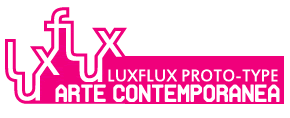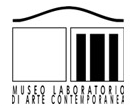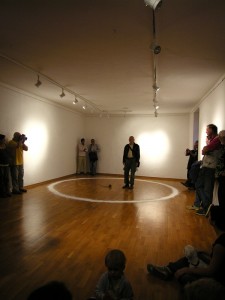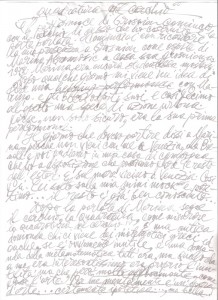Iljia Soskic (Decani, 1934) was invited to the 2011 Venice Biennale of international art, for the Montenegro Pavilion to participate in The Fridge Factory and Clear Waters Ilija Soskic, Natalija Vujozevic, curated by Marina Abramovic Cetinje Community Center Obod. Commissioners: Petar Cukovic, Svetlana Racanovic. Venue: Palazzo Malipiero, San Marco 3079.
In recounting some of the most recent performances by Soskic in Italy and Croatia in the second half of 2010, we are pleased to preview a few passages of the volume on the artist being prepared by Simonetta Lux. Consisting of autobiographical interviews and the artist’s Autobiographical Manuscripts (edited by Dragica Soskic and Simonetta Lux. Transcriptions by Vania Granata). The autobiographical texts are of particular interest given that – despite the artist’s fame in Europe and the Balcans – his complex biography is not already known, a true master of the generations that did not live through the dramatic transition from Tito’s Yugoslavian federation, through the fratricidal war of 1992-1995. Soskic’s art is testament to his condition under Tito, to the original presence and the exchanges between Yugoslav artists and European and international contemporary art, as well as to the dramatic transition to the actual state of the nations of the former Yugoslavia.
Iljia Soskic is one of the artists that I have followed since 1986, who returned to Italy as a refugee (1991), and has participated in numerous initiatives of the MLAC – Museo Laboratorio di Arte Contemporanea of La Sapienza University of Rome. See entry Archivio Museo Laboratorio di Arte Contemporanea in the journal www.luxflux.net.
I go to Grisignana/ Groznjan on the 11th of September 2010: in fact, they invite me: Soskic is there, they say. I travel by Train, Venice, then Trieste. Then by car, across the Istrian border. Grisignana is a few kilometres away, a small city (covering 68 sq km, with a thousand inhabitants) of the Presidential Republic of Croatia, in the Istrian Region. Previously it was an irredentist centre of Hapsburg Italy, bilingual city of Zone B of the “Free Territory of Triest”, city of the Italian exodus between 1945-55. The city in which Tito favoured the settlement of artists. Tito, in fact, had wished to offer a centre of cultural aggregation in every city or small town in Yugoslavia, whether of theatre, cinema, visual arts, etc., supporting the free circulation of artists and art in Europe. And, as I have already written (see Speciale Biennale di Sarajevo, Regiones, n.38/2010 and Speciale Jusuf Hadžifejzovic, Art in Theory, n. 37/2009), it should not come as a surprise if an artist, even if invited as a great master, moves for everyone, even small centres of art, as, in the end, they are all extremely significant. A cultural costume of movements within the former Yugoslavia, and naturally also back and forth throughout Europe, was maintained during the open war against the other Yugoslavia, a war waged by Milosevic against the construction of new independent Republics (the first of which was Croatia). The greatest artists and poets of the various countries at war with each other during the nineties continued, even dangerously, to meet and see each other, to continue exchanging (at times in danger) experiences and events in a friendly way.
The logic of peace and the liberty of art against the logic of war and dominion. “I heard stories from Ilija about the war and his thoughts; those of a man, who lives his experiences as an artistic event and makes an experience of artistic expression. Intense, absolutely not banal.”
This train that goes from Venice to Trieste and back is truly old, degraded, but with the furnishings, the upholstery, the fifties/sixties design, that represented the close nit exchange of art and design between Italy and Yugoslavia (I am thinking of the biennales of Zagreb, etcetera: events that I think Dunja Blasevic is writing about, Soskic’s friend from Belgrade from the sixties, then Director of the Student Cultural Centre, then director of the Soros Centre for Contemporary Art, today in Sarajevo, the director of an important Centre for Contemporary Art).
The evening of the 12th of September 2010, in Groznjan/Grisignana, Ilija Soskic enters into the room of the micro-museum of contemporary art, the Gradska Galerija (City Gallery). His space is empty. The other participants exhibit works of art that are traditional yet relevant (photographs, wall installations, paper works, paintings) in the other rooms of the Gallery.
Ilija trails a circle of chalk powder in the centre of the space, and holds in his hand “a length of string at the end of which the rest is rolled into a ball. A large nail – Soskic had written to me two or three days earlier – is tied to the rope that fixed the centre in order to draw the perfect geometric circle with the chalk”. The public is all around. The artist speaks.
Today I ask Iljia: what were you saying?
He responds like this:
Ilija Soskic. Squaring the circle
The performance of Grosnian (sic=Groznjan) began with a circle of chalk that I made and the spoken part. I began by recalling my presence in Grosnian (sic=Groznjan) as a guest of Marina Abravmovic at her Grosnian house, 1972. Marina was still a master’s student. After a few days, I had the idea of doing a hepening – performance (sic = happening – performance) with Marina and her other guests, and so we carried a kind of urban action out in the open air. Perhaps, I am not sure, it was her first performance. The day I had to leave I said to Marina, why don’t you come with me to Venice, to the Biennale, and then we can go to a house in the country that I can use so we can spend the rest of the summer there. It is on the beach near Venice. So she jumped aboard my mini jeep and we left… the rest is already well known… After the talk about Marina the circle followed, the squaring, how do you measure the squaring of the circle!? It is an ancient question that comes to us from the Greek mathematicians, and even if it is obviously useless, it is still a mathematical problem today, but what I found extremely interesting was precisely this uselessness that was however very interesting (dazzling), as though art. For me it is mentally an artwork… certainly hypothetical…, but beautiful”.
8 March 2011 I transcribed Squaring the circle today, 5 months since the group exhibition of Grisgnana/Groznjan. It is the transcript of the text written by Ilija Soskic in watercolour on A4 paper, at my request, on the 8th of March 2011, to tell me in full what he told the people seated around the circle he had drawn, of which he was inside.
I had thought then, seeing him continuously pointing to the inside and outside, that he was addressing, from his particular place of art (in the circle), somebody who was outside (the spectators), and that, continuously pointing to the inside and out, he was referring to himself, being an artist whose life, as both man and artist, was tied to his country and the context of Yugoslavia beforehand and his state as a refugee in Greece and Italy afterwards. And that this also signified, or also wanted to convey, that his art, performative and often dematerialized (working with the body itself and creating inclusive and vaguely symbolic devises or throw backs of artistic biography), was in a sense tied to a certain advanced international language of art (being inside the circle), and in another sense strongly hinged, motivationally and finalistically, on the socio-political context of its origin (being here in Groznjan, for example). And vice versa, because his is the operating in the dialectic between the two “circles” (the original contextual one and that of the legitimate language of art; as well as the circle of the east and the one of the west), like on the edge of a razor that separates originality and subjection, the work of the artist inside/outside the so-called advanced western “art system”. This work on the crest, an interstice of creative liberty, is that which I have defined “hyper-contemporary art” in Arte ipercontemporanea. Un certo loro sguardo. Ulteriori protocolli dell’arte contemporanea (Rome, Gangemi, 2008). And the “art system”, nevertheless, a “no man’s land”, without which no “original” artistic action could take place, nor could an “ethical” action (that is based on a critical consciousness of the world): the “immaterial” protection of the “no man’s land of art” can save the life of the artist operating in authoritarian countries.
————————
In part I was right: for example, the recollection without details, which Soskic today tells me he made, of the action/performance with Abramovic thirty years earlier (and not knowing his language I did not know he had made), is, it seems, this exact message: there, in ‘72, the performance art of Marina Abramovic was born, and her respect for and friendship with Ilija Soskic (1). The close dialectic between the two elements: the original context matrix (ones own national and cultural homeland) and language (knowing and choosing in the European transnational artistic context), is the foundation of his art and his acknowledged mastery.
(1) In truth, Ilija Soskic and Marina Abramovic identify this as the original act (not yet an artwork) that would later make them into performance artists, for whom putting their own bodies into play is central. Ilija recalls that, as an adolescent, during a family reunion, following his father’s violent refusal to let him undertake artistic studies, he closed himself in the bathroom. After cutting off both his eyebrows, he presented himself to his family, as though everythingdoc was normal. They were all horrified and scandalized, apart from one uncle who defended the young Ilija and supported his artistic studies. Marina Abramovic, in a short autobiographical video, Marina’s first performance, now on You Tube http://www.youtube.com/watch?v=1DxZKAQ9WrM. Forming part of the long video interview on the occasion of her exhibition at MOMA New York (www.moma.org) Marina Abramovic: The Artist Is Present, 14th March – 31st May, 2010.
Marina recalls that when she was young she had orthopaedic shoes and hair in a bob down to her eyes. She was horrified when she would look at herself in the mirror. She loved Brigitte Bardot, of whom she had a series of photographs cut out from newspapers. One day she decided to find a way to get taken to hospital, unsheathing her little collection of photos, to remake her face: in her room, she began to spin around ever quicker until falling violently on the bed head, in order to break her nose. In reality, she only broke her right cheek and her mother, after giving her a customary smacking, got her treated simply. This, says Marina, I consider my first performance, even if it has nothing to do with art.








